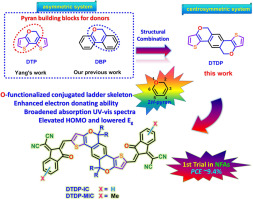Nano Energy ( IF 17.6 ) Pub Date : 2017-12-19 , DOI: 10.1016/j.nanoen.2017.12.030 Yuanyuan Zhou , Miao Li , Jinsheng Song , Yahui Liu , Jianqi Zhang , Lisi Yang , Zhe Zhang , Zhishan Bo , Hua Wang

|
Molecular electronic structure plays a vital role in the photovoltaic performances in nonfullerene polymer solar cells (PSCs) due to their influences on light-harvesting, charge carrier transfer, π-π stacking and morphology tuning etc. Oxygen as an electron donating atom, which has been incorporated into the nonfullerene acceptors (NFAs) system in the alkoxy forms at central, terminal or π bridged moieties, could effectively tune the electron donating ability, absorption spectra, energy levels of the highest occupied molecular orbital (HOMO) & lowest unoccupied molecular orbital (LUMO) etc. In this contribution, a novel centrosymmetric pyran based ladder-typed conjugated building block (DTDP) has been designed and synthesized via a facile route and it was applied as the donor (D) core in acceptor-donor-acceptor (A-D-A) type NFAs design to evaluate its potential usage in polymer solar cells. This incorporated-O in the conjugated backbones effectively elevated the electron donating ability for the D moiety and wide absorption behaviors are observed. Although slight bent appears at the central part of the DTDP block from the geometry quantum optimization, strong crystallinity are found for both molecules. Photovoltaic performances of the solar cell devices are systematically investigated with poly[(2,6-(4,8-bis(5-(2-ethylhexyl)thiophen-2-yl)benzo[1,2-b:4,5-b′]dithiophene)-co-(1,3-bis(5-thiophene-2-yl)−5,7-bis(2-ethylhexyl)benzo[1,2-c:4,5-c]dithiophene-4,8-dione)] (PBDB-T) as the polymer donor and a high power conversion efficiency (PCE) of 9.39% (Voc = 0.80 V, Jsc = 16.82 mA/cm2 and FF = 69.95%) could be afforded by DTDP-MIC after the preliminary optimization, demonstrating the great promise in PSCs. Meanwhile, the morphologies as well as the carrier mobilities of the blend films are gleaned to assist understanding the structure-property relationships. Overall, the study in this work not only provides a promise ladder-typed dipyran donor unit for NFAs PSCs, it also paves a new way to use oxygens in small molecule NFAs design.
中文翻译:

基于新型O-官能化梯型双季戊烷构建基的高效小分子受体
分子电子结构对非富勒烯聚合物太阳能电池(PSC)的光伏性能起着至关重要的作用,因为它们会影响光收集,电荷载流子转移,π-π堆积和形态调整等。作为供电子原子的氧具有以中心,末端或π桥接部分的烷氧基形式并入非富勒烯受体(NFAs)系统中,可以有效地调节最高占据分子轨道(HOMO)和最低未占据分子轨道的电子给予能力,吸收光谱,能级(LUMO)等。在此贡献中,一种新型的基于中心对称吡喃的梯型共轭构建基块(DTDP)已通过一种简便的途径进行设计和合成,并将其用作受体-供体-受体(ADA)型NFA设计中的供体(D)核心,以评估其在聚合物太阳能电池中的潜在用途。在共轭主链中掺入的-O有效地提高了D部分的电子给体能力,并且观察到宽的吸收行为。尽管根据几何量子优化,DTDP嵌段的中心部分出现了轻微弯曲,但两个分子均具有很强的结晶度。用聚[(2,6-(4,8-双(5-(2-乙基己基)噻吩-2-基)苯并[1,2- b:4,5- b '] dithiophene)-co-(1,3-双(5-噻吩-2-基)-5,7-双(2-乙基己基)苯并[1,2- c:4,5- c ]二噻吩-4,8-二酮)] DTDP-MIC可以提供(PBDB-T)作为聚合物供体,并具有9.39%(V oc = 0.80 V,J sc = 16.82 mA / cm 2和FF = 69.95%)的高功率转换效率(PCE)经过初步优化,证明了PSC的巨大前景。同时,收集共混膜的形态和载流子迁移率以帮助理解结构-性质关系。总的来说,这项工作的研究不仅为NFA的PSC提供了一种有希望的阶梯型双吡喃供体单元,还为在小分子NFA设计中使用氧气开辟了一条新途径。



























 京公网安备 11010802027423号
京公网安备 11010802027423号